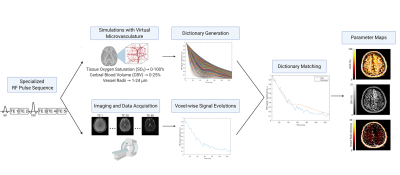Gregory J. Wheeler1 and Audrey P. Fan1,2
1Biomedical Engineering, University of California Davis, Davis, CA, United States, 2Neurology, University of California Davis, Davis, CA, United States
1Biomedical Engineering, University of California Davis, Davis, CA, United States, 2Neurology, University of California Davis, Davis, CA, United States
Accelerating acquisition for MR vascular fingerprinting will enable
dynamic quantitative vascular parameter mapping and new investigations of
vascular diseases. This simulation study investigated SNR, time resolution, and
mapping accuracy tradeoffs that will arise from acceleration.

Figure 1. Overview of the MR vascular
fingerprinting technique. A pulse sequence sensitive to the vascular parameters
of interest is utilized for both imaging and MR physics simulations. Physiological
ranges of SO2, CBV, and vessel radii
are used to simulate the MR signal in a virtual voxel with each combination of
those parameters. After the images are acquired, the time-course signal
evolution of each voxel is compared to all dictionary entries. The closest
match between the fingerprint and dictionary allows for the extraction of the underlying
parameters for quantitative mapping.

Figure 5. Mean RMSE of vascular parameters predicted from matching
algorithm and the signals true underlying parameter values at five SNRs and
with five echo train lengths. The RMSE for each parameter was calculated by
taking 10 random parameter combinations and finding the RMSE at each SNR/TE
combination. This was repeated 1000 times resulting in 10,000 total RMSE values
for each SNR/TE combination tested. The means and standard deviations were calculated
and plotted as the dots and error bars in the graphs.
